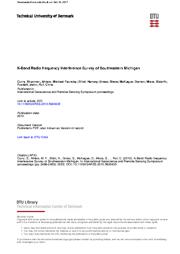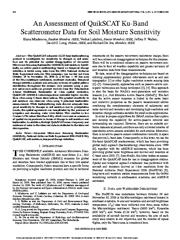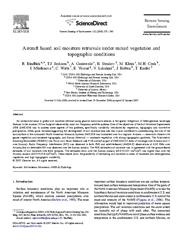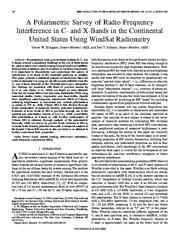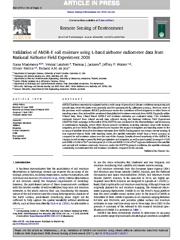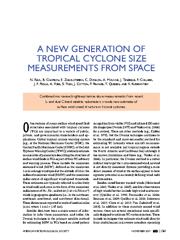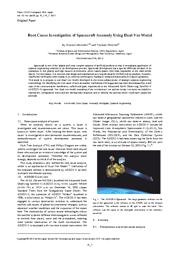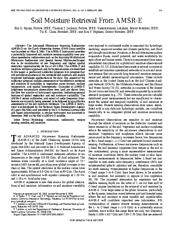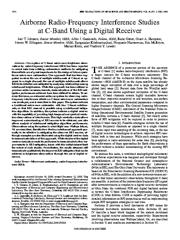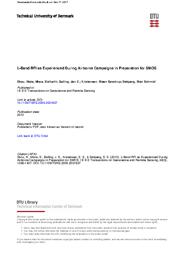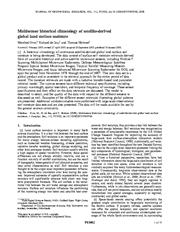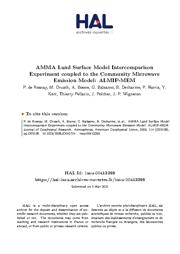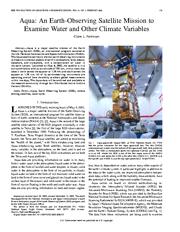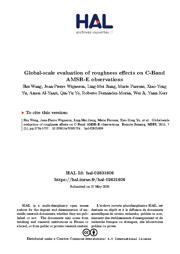A copy of this work was available on the public web and has been preserved in the Wayback Machine. The capture dates from 2019; you can also visit the original URL.
The file type is application/pdf.
Filters
K-Band Radio frequency Interference Survey of Southeastern Michigan
2010
2010 IEEE International Geoscience and Remote Sensing Symposium
The Radio frequency Interference Survey of Earth (RISE) is a new type of instrument used to survey and characterize the presence of Radio Frequency Interference (RFI) that can affect microwave radiometers ...
A kurtosis detector is included in RISE to reliably detect the presence of RFI, even at very low levels, and to aid in its characterization. ...
ACKNOWLEDGEMENTS The authors would like to acknowledge the valuable assistance of D. Boprie, J. Peng, L. Marcoux (University of Michigan), and D. Kovach (Michigan Flyers). ...
doi:10.1109/igarss.2010.5649435
dblp:conf/igarss/CurryAEGMMPR10
fatcat:df43ibnsh5e3xgxve27q4mtqiy
An Assessment of QuikSCAT Ku-Band Scatterometer Data for Soil Moisture Sensitivity
2009
IEEE Geoscience and Remote Sensing Letters
QuikSCAT-AMSR-E intercomparisons indicated higher correlations when using C-band observations. The greatest sensitivity to soil moisture was observed when using V-polarized backscatter measurement. ...
In addition, the high QuikSCAT sensor frequency and existence of noise in the observed data contributed to the observed discrepancies. ...
Initial setup and maintenance were funded by the Australian Research Council (DP0343778). ...
doi:10.1109/lgrs.2009.2021492
fatcat:eo4m2cr66bdwbkotrsiwnrtsxu
Aircraft based soil moisture retrievals under mixed vegetation and topographic conditions
2008
Remote Sensing of Environment
Radio Frequency Interference (RFI) was observed in both PSR and satellite-based (AMSR-E) observations at 6.92 GHz over Arizona, but no detectable RFI was observed over the Sonora domain. ...
The Polarimetric Scanning Radiometer (PSR/CX) was flown on a Naval Research Lab P-3B aircraft as part of SMEX04 (10 dates of coverage over Arizona and 11 over Sonora). ...
Acknowledgements This work was supported by the National Aeronautics and Space Administration (NASA) EOS AMSR Instrument Science Program, NASA Terrestrial Hydrology Program and the Aqua AMSR Science Program ...
doi:10.1016/j.rse.2007.01.024
fatcat:c3shdcn6rbdureljsfijhce5um
RFI and remote sensing of the Earth from space
2016
2016 Radio Frequency Interference (RFI)
Interference from manmade sources (radio frequency interference) is an impediment that in many cases limits the potential for accurate measurements from space. ...
in desired parameters) and by the availability of suitable spectrum free from interference. ...
Global studies of RFI at C-band show that the use of this band varies significant by country, with larger interference in the Middle East, Asia, and Japan, and lesser use in other regions. ...
doi:10.1109/rfint.2016.7833530
fatcat:ph4mtcglcbczpfkm6sqlkp2pji
A polarimetric survey of radio-frequency interference in C- and X-bands in the continental united states using WindSat radiometry
2006
IEEE Transactions on Geoscience and Remote Sensing
Results show significant radio-frequency interference (RFI) at C-band, including brightnesses in horizontal and vertical polarizations in excess of 330 K, while X-band RFI is less obvious through direct ...
Transmissions from ground-based systems in C-and X-bands present a significant challenge to the use of these bands for passive microwave remote sensing from aircraft and satellites. ...
ACKNOWLEDGMENT The authors thank the Naval Research Laboratory (NRL) WindSat team (led by P. Gaiser) for providing the WindSat data used in this study. L. ...
doi:10.1109/tgrs.2005.856131
fatcat:snqmivtugfhbvpa2v6uyidhjei
Validation of AMSR-E soil moisture using L-band airborne radiometer data from National Airborne Field Experiment 2006
2011
Remote Sensing of Environment
Here, C-band based AMSR-E soil moisture estimates are evaluated using 1 km resolution retrievals derived from L-band aircraft data collected during the National Airborne Field Experiment (NAFE'06) field ...
AMSR-E has been extensively evaluated under a wide range of ground and climate conditions using in situ and aircraft data, where the latter were primarily used for assessing the T B calibration accuracy ...
The aircraft instrument operates at a lower frequency, (L-band); therefore, the AMSR-E (C-band) sensor in this case will be associated with the shallower penetration depth. ...
doi:10.1016/j.rse.2011.04.011
fatcat:acjagyz32ngdfehvipmddvxur4
A New Generation of Tropical Cyclone Size Measurements from Space
2017
Bulletin of The American Meteorological Society - (BAMS)
measurements from several C-or X-band frequency channels. ...
Signals at these two C-band frequencies have similar sensitivity to the sea wind speed but differ in sensitivity to rain by about 12%. ...
It's easier than ever for the weather, water, and climate community and the general public to search for organizations and individuals offering these important services. ...
doi:10.1175/bams-d-15-00291.1
fatcat:urad3mxdz5g6jnzf56h6kurldm
Root Cause Investigation of Spacecraft Anomaly Using Dual Vee Model
2012
TRANSACTIONS OF THE JAPAN SOCIETY FOR AERONAUTICAL AND SPACE SCIENCES AEROSPACE TECHNOLOGY JAPAN
The Dual Vee Model consisting of the Architecture Vee and the Entity Vee turns out helpful to express the configuration items and the development sequence and to identify the process which could have caused ...
Spacecraft is one of the largest and most complex systems of artificial products so that it necessitates application of systems engineering methods in its development process. ...
Acknowledgments The authors appreciate the discussion with the Strategic System Design Laboratory members of the Graduate School of the System Design and Management, Keio University. ...
doi:10.2322/tastj.10.pt_1
fatcat:imbsqob7yjekxfoo6yehcwd4le
Soil moisture retrieval from AMSR-E
2003
IEEE Transactions on Geoscience and Remote Sensing
The AMSR-E sensor calibration and extent of radio frequency interference are currently being assessed, to be followed by quantitative assessments of the soil moisture retrievals. ...
The AMSR-E soil moisture retrieval approach and its implementation are described in this paper. ...
Passive measurements at frequencies below L-band are susceptible to man-made radio-frequency interference (RFI) and extraterrestrial galactic radiation and are, therefore, unsuitable for earth sensing. ...
doi:10.1109/tgrs.2002.808243
fatcat:xza553cm2bcvvht5trmtpdbtnu
Airborne radio-frequency interference studies at C-band using a digital receiver
2006
IEEE Transactions on Geoscience and Remote Sensing
Corruption of C-band microwave brightness observations by radio-frequency interference (RFI) has been reported in recent data from orbiting radiometers; methods for mitigating these effects are of great ...
Index Terms-Microwave radiometry, radio-frequency interference (RFI). ...
Airborne Radio-Frequency Interference Studies at C-Band Using a Digital Receiver I. ...
doi:10.1109/tgrs.2006.872523
fatcat:idwjvdpigreu5gnrvjr2hacyo4
L-Band RFI as Experienced During Airborne Campaigns in Preparation for SMOS
2010
IEEE Transactions on Geoscience and Remote Sensing
The radiometer used in this context is fully polarimetric and has built-in radio-frequency-interference (RFI)-detection capabilities. ...
In support of the European Space Agency Soil Moisture and Ocean Salinity (SMOS) mission, a number of soil moisture and sea salinity campaigns, including airborne L-band radiometer measurements, have been ...
ACKNOWLEDGMENT The authors would like to thank Helsinki University of Technology for providing and operating the aircraft, with S. ...
doi:10.1109/tgrs.2009.2031637
fatcat:ch7yiyfxnbar7enwqs3aniwute
Multisensor historical climatology of satellite-derived global land surface moisture
2008
Journal of Geophysical Research
The model is described in detail, and the quality of the data with respect to the different sensors is discussed as well. ...
This new data set is a global product and is consistent in its retrieval approach for the entire period of data record. ...
Support for various phases of this research was provided by the Modeling, Analysis, and Prediction Branch of NASA Headquarters and the Department of Geo-environmental Sciences, Vrije Universiteit, Amsterdam ...
doi:10.1029/2007jf000769
fatcat:kjvwtlv56bexthzw52egye6kne
AMMA Land Surface Model Intercomparison Experiment coupled to the Community Microwave Emission Model: ALMIP-MEM
2009
Journal of Geophysical Research
Simulations have been performed for an incidence angle of 55°, and results are evaluated against C-band satellite data from the Advanced Microwave Scanning Radiometer on Earth Observing System (AMSR-E) ...
For most of the LSMs, the Kirdyashev opacity model is the most suitable to simulate TOA brightness temperature in best agreement with the AMSR-E data. ...
) cell spacing [Njoku, 2004] . [9] Possible Radio Frequency Interference (RFI) is observed in the 6.9 GHz and 10.7 GHz (X-band) channels [Njoku et al., 2005; Li et al., 2004] . ...
doi:10.1029/2008jd010724
fatcat:4uzipio3mfgvfay5naputiylvi
Aqua: an earth-observing satellite mission to examine water and other climate variables
2003
IEEE Transactions on Geoscience and Remote Sensing
The Aqua satellite carries six distinct earth-observing instruments to measure numerous aspects of earth's atmosphere, land, oceans, biosphere, and cryosphere, with a concentration on water in the earth ...
All of its earth-observing instruments are operating, and all have the ability to obtain global measurements within two days. ...
Thus, despite the limitations (which also include 6.9-GHz radio frequency interference in some regions, as discussed in [42] ), the AMSR-E soil moisture measurements are an exciting new possibility, and ...
doi:10.1109/tgrs.2002.808319
fatcat:kr3bwr33fzchpoqxlct7o6nwte
Global-Scale Evaluation of Roughness Effects on C-Band AMSR-E Observations
2015
Remote Sensing
In the first step, we retrieved a parameter (referred to as the * parameter) accounting for the combined effects of roughness and vegetation. ...
AMSR-E brightness temperatures at 6.9 GHz obtained from January 2009 to September 2011, together with estimations of soil moisture from the SMOS (Soil Moisture and Ocean Salinity) L3 products and of soil ...
Author Contributions Jean-Pierre Wigneron contributed important ideas and considerations. Shu Wang processed AMSR-E and SMOS data and wrote the paper. ...
doi:10.3390/rs70505734
fatcat:p6almvlt6jenbgrifjtk5z32ma
« Previous
Showing results 1 — 15 out of 103 results

